#otariidae
Text
Today's Seals Are: Sailing The High Seas


603 notes
·
View notes
Photo
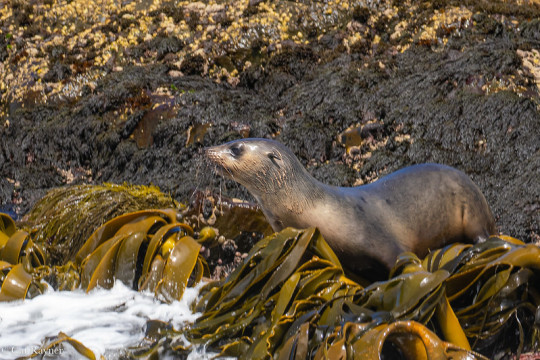
A Brown fur seal (Arctocephalus pusillus) in Australia
by Cat Rayner
#brown fur seal#Arctocephalus pusillus#arctocephalus#Otariidae#pinnipedia#carnivora#mammalia#chordata#wildlife: australia#seals
200 notes
·
View notes
Text


South American fur seal (L) – The South American fur seal ranges from Peru to southern Brazil, with most of the population living in Uruguay and the Falkland Islands. Their diet varies greatly depending on where they live, but unlike most pinnipeds they prefer to hunt in groups. Unfortunately they like to live in many of the same areas as the South American sea lion. Male South American sea lions will steal fur seal pups and kill them if they can. Like the Galapagos fur seal, South American fur seals nurse their pups for a comparatively long time.
Subantarctic fur seal (R) – Their range is a long band across the Atlantic, Pacific, and Indian Oceans just above the Antarctic Circle (hence "Subantarctic"), though some far-travelers have settled in Tasmania. Both males and females have gray fur on their backs and orange/cream fur on their undersides. Because their preferred fish migrates close to the surface, they have one of the shallowest dive depths of any pinniped.
#south american fur seal#subantarctic fur seal#fur seal#pinnipeds#pinniped#otariidae#tumblr pinniped contest#round 1#marine mammals
23 notes
·
View notes
Link
11 notes
·
View notes
Text
the pinniped hyperfixation is absolutely railing me rn. I’m so happy
#shitpost#pinnipeds#phocidae#otariidae#seals#sea lions#walrus#marine biology my beloved#actually neurodivergent#marine science#marine mammals
0 notes
Text
Wet Beast Wednesday: walrus
There are a lot of iconic arctic animals, such as the polar bear and narwhal, but my personal favorite is the walrus. Known for their large tusks, prominent whiskers, and habit for busting myths creepy eyes, walruses are unique amongst the pinnipeds. Most people know of the two main groups of pinnipeds: Phocidae, the earless or true seals and Otariidae, the fur seals and sea lions. Walruses however are in a class of their own, being the only surviving species of their own family: Odobenidae. A weird fact that I learned researching for this is that taxonoimists used to think Odobenids evolved from bears before later reclassifying them alongside the other pinnipeds. Old-timey taxonomy was wild and came up with some absolutely unhinged ideas. Like they used to think that microbats and megabats weren't related, instead classifying megabats as primates.

(image; a walrus sitting on an ice flow. It is a large, brown mammals with short limbs that end in flippers. Its head has a wide, blunt snout and two long tusks emerging from the upper jaw)
There is one species of walrus, Odobenus rosmarus, divided into two subspecies based on location: the Atlantic walrus (O. r. rosmarus) and Pacific walrus (O. r. divergens). The two subspecies are still very similar and genetic testing indicates they diverged between 750,000 and 500,000 years ago. There used to be a third listed subspecies from the Laptev sea, O. r. laptevi, but they have since been reclassified as a population of the Pacific walrus. Walruses are very large, being the third largest pinnipeds after the two elephant seal species. The Pacific subspecies is larger than their Atlantic brethren with most males reaching an average weight between 800 and 1,700 kg (1,800 to 3,700 lbs). A few males have been known to grow considerably larger than average. Male Atlantic walruses average about 900 kg (2,200 lbs). In both subspecies, females are about 2/3 the size of males and have shorter tusks. a large portion of their weight comes from the thick layer of blubber under their skin that helps them stay warm. Both subspecies have an average length between 2.2 and 3.6 meters (7.4 to 11.8 ft). Walruses have hind flippers that can turn forward to act like feet, letting them crawl on all fours like sea lions. Like true seals, they have no external ears. The skin is very thick and mostly bald. They are born with brown skin that becomes lighter as they age. While swimming, the blood vessels in the skin construct to reduce blood flow and limit heat loss, which makes them considerably lighter, almost white. Males have skin nodules called bossed around the neck and shoulders. Their creepy eyes are the result of eye sockets with no roof and powerful extraocular muscles that let the eyes protrude out of the skull and look both forward and sideways. The famous mustaches are composed of 400-700 thick whiskers. The whiskers are attached to muscles and have both nerve ending and blood supply. They are incredibly sensitive sense organs and a walrus can identify objects as small as 2mm with its whiskers. Their lips are muscular and flexible and aid in creating a large variety of noises.

(image: a close-up of a walrus's face, showing its prominent whiskers and small eyes. Its mouth is open, revealing its tongue)
youtube
How come the walrus can whistle but I can't? (video: a walrus in a zoo being instructed by its handler to make multiple vocalizations)
Of course the most famous features of walruses are their tusks. These two large canines can reach a meter in length and are larger in males than females. The tusks have a number of uses in both sexes, though males use them more. In both sexes, they are used to help dig breathing holes in sea ice, hang onto ice and help the walrus climb out of the water. Males also use their tusks in displays of dominance, especially during mating season. Larger tusks are a sign of dominance and typically the walrus with the largest tusks will win standoffs. If a standoff escalates from posturing to a fight, they will use their tusks as weapons. They tend to strike around the neck and shoulders and the skin nodules in those areas help protect males from each other's tusks. It was formerly believed that walruses would use their tusks to dig for prey on the sea floor, but this is no longer believed to be the case.

(image: a walrus skull showing the tusks)

(image: a walrus using its tusks to hang onto the ice and keep its nostrils above the water)
Walruses spend a lot of their time searching for the food they need to support a body that big. They prefer forging along the continental shelf and spend much more time in shallow water than other pinnipeds. While walruses have been tracked diving 500 meters deep, the majority of dives are much more shallow. The vast majority of a walrus's diet consists of seafloor-dwelling invertebrates including tubeworms, soft corals, tunicates, crabs and shrimp, sea cucumbers, and mollusks. While that's a wide palette, their absolute favorite food is clams. To hunt, walruses drag their noses and the forward surface of their tusks through the sediment and use their whiskers to search for food. This stirs up the sediment and releases nutrients back into the water column, a process balled bioturbation. Many foods can be swallowed whole or chewed, but they have a special feeding style for clams and other bivalves. Walruses will hold the bivalve in their mouths and use their flexible lips to form a water-tight seal around it. It then withdraws its tongue into its mouth to create enough suction to suck the bivalve meat right out of the shell. So important is this strategy to feeding that the shape of their mouths is specially adapted to it. Walruses are also known to feed on seals, though how much of that is due to hunting or scavenging is unknown. Additionally, they will scavenge whales, may hunt walrus trapped under sea ice, and have been seen catching and eating birds.
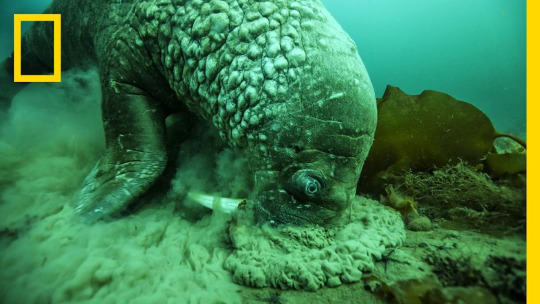
(image: a walrus foraging for food underwater. It has its snout pressed into the sea floor and is kicking up a large amount of sediment. Still from a National Geographic video)
Walruses are social and migratory, traveling south for the winter and north for the summer in aggregations that can be tens of thousands strong. They will haul out onto land or sea ice in huge numbers, blanketing the landscape in blubber and tusks. While these aggregations are preferred, they are not considered a true social species as they do not aid each other when together. Walruses on land or ice are skittish and will spook easily. Being startled can lead to stampedes while the walruses flee back to sea. Sometimes, walruses will be trampled to death during these stampedes. During mating season, the normally cordial walruses become much less friendly to their neighbors. Breeding seasons lasts from January to March. During this time, males will gather in the water around females in heat and compete for the change to get to that nice walrussy (I will not apologize). This is usually done via bellowing and posturing with the tusks, but may escalate to fights. While males become sexually mature around age 7, they often do not become large and strong enough to secure mates until around age 15. Females become sexually mature between 4 and 6 years old. Curiously, females enter heat twice per year, but males are only fertile once per year. Gestation takes up to 16 months and calves are born able to swim and weighing up to 75 kg (165 lbs). Females with calves move away from the large aggregations, possibly to keep their calves from being crushed in stampedes and possibly to make it harder for predators to detect their scent. Nursing lasts for over a year, longer than in many pinnipeds. Walrus milk is fattier than that of land mammals, but less fatty than that of true seals, forcing walrus mother to nurse longer. Even after being weaned, walruses may spend up to 5 years with their mothers. Females only mate at most every two years, which gives the walrus the lowest reproduction rate of all pinnipeds. Walruses can live up to 30 years in the wild and 40 years in captivity. Male walruses have the largest penis bone of any non-cetacean both in absolute size and proportionately.
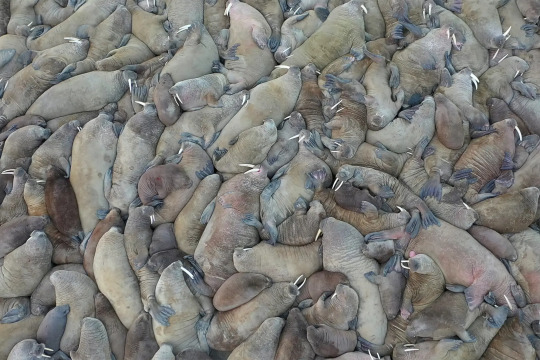
(image an aerial shot of a walrus herd on land. There are many walruses and they are so tightly packed together that no ground is visible)

"Don't talk to me or my son ever again" (image: a mother walrus with its calf. The calf is a smaller version of the mother with no tusks. The calf is sittting by its mother's side. Both are looking at the camers)
Walruses have been hunted by humans living in the arctic circle for millennia. Hunting peaked in 18th and 19th centuries when there was a high commercial demand for meat, blubber, skin, and ivory. This almost led to the extirpation of Atlantic walruses. Since then, hunting has been outlawed except by indigenous peoples, allowing the populations to recover. Now, the major threat to walruses is climate change leading to loss of sea ice needed for hauling out and breeding. The IUCN lists both subspecies as Vulnerable. They were an important source of food and other materials to the peoples of the arctic circle and appear frequently in the mythology of said peoples.

(image: a walrus tusk carved with the images of multiple fish, seals, and polar bears)
#wet beast wednesday#walrus#pinniped#marine biology#zoology#ecology#marine mammals#animal facts#biology#Youtube
503 notes
·
View notes
Note
hi what is a seal
this is actually a great question! a true seal, or earless seal, belongs to a group of marine mammals known as pinnipeds, which is Latin for "flipper-footed!" there are three families in the Pinnipedia order: Odobenodae (walruses), Otariidae (sea lions and fur seals) and Phocidae (true seals).
true seals are often confused with sea lions or fur seals, but there are actually several traits that make them unique! take a look at these photos of a harbor seal (left) and a California sea lion (right). what differences do you notice?
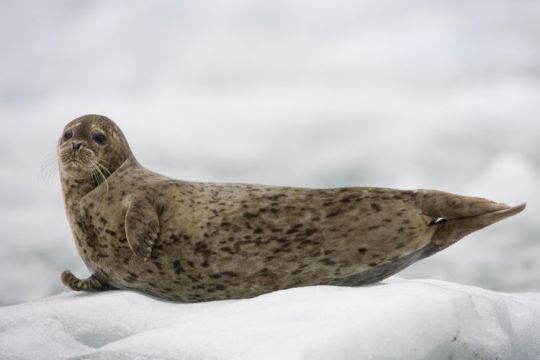

one of the biggest noticeable differences between seals and sea lions is the ears. sea lions have external ears, whereas seals just have an ear hole, which can sometimes be difficult to spot. here's a closer look:
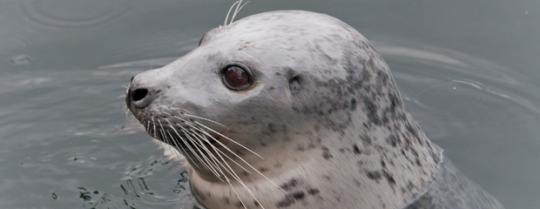
another big difference is their flippers! sea lions have longer front flippers than seals, and can also rotate their hind flippers and walk on them! seals can't do this, so on land they move in an ungainly, caterpillar-like motion called galumphing. this video of a seal release from the Cornish Seal Sanctuary will give you a good idea of what seals look like when they galumph.
youtube
kind of funny, right? don't let them fool you, though -- they can move pretty fast when they want to! these elephant seal bulls are galumphing so fast that their long noses (called proboscises) almost get in the way.
youtube
there are nearly 20 species of true seals, ranging in size from around 3.5 feet long (baikal seal) to 20 feet long (southern elephant seal). the largest seal on record was a southern elephant seal that was measured at 22.5 feet in 1913. (side note: if you have some spare time and a tape measure, and like me, you have trouble conceptualizing exactly how big this is, try measuring it out! i was a little terrified to find that this seal would have stretched from my apartment bedroom nearly all the way to the kitchen).
in conclusion, a seal is a strange and wonderful type of creature. seals are distinct from sea lions, and each species of seal is incredibly diverse and weird in its own way! here are a couple photos of these majestic beasts:

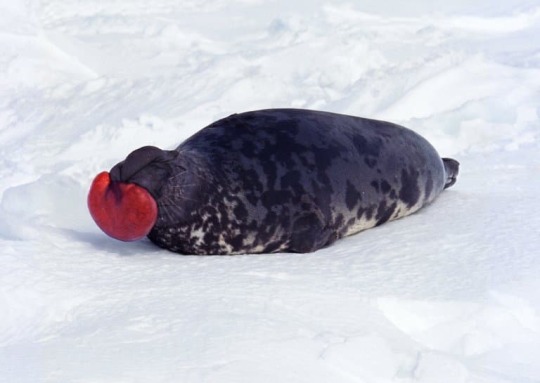




(images: baikal seal, hooded seal, grey seal, weddell seal, northern elephant seal, bearded seal)
9 notes
·
View notes
Text
seal of the day: japanese sea lion
content warning: graphic descriptions of animals bodies post death
sadly these eared seals went extinct in the 1970s :( they inhabited the japanese sea and surrounding areas. a text from the 18th century said that their meat “was not tasty” and instead was used as oil for oil lamps. their organs were used for expensive medicine, whiskers as pipe cleaners, and skin for leather (yes really.) over hunting caused their population to go from 300 japanese sea lions in 1915 to only a few dozen in the 1930s. over hunting and damage to their habitat from world war 2 is to blame for their extinction. i’m sorry we failed you, japanese sea lions :( what are ur thoughts on this otariidae?
ps. there are like no good photos since they are extinct, so what i have here are drawings and a taxidermied sea lion. also a b&w photo taken in 1934
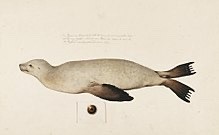



#frickyeahseals#seal#seals#harp seal#seal pup#seal facts#animal#animal facts#mammal#marine mammals#sea lion#japanese sea lion#japan#extinct#extinct animals#extinct animal
48 notes
·
View notes
Text
"that's not a seal it has ears" "that doesn't look like a seal" "why are you posting sea lions on a seal blog" Respectfully, otariidae have always been seals because language and clades are fake
#★ phantompost#Its amazing that people still do this woth sealsdaily tags i really didn't know americans classify them like this
2 notes
·
View notes
Text
Intro and Sophont List
This is a DnD rehaul inspired by @danbensen's Fellow Tetrapod story.
All races and classes available to DnD 5e will be reinterpreted as a sophont according to his guide for making FT sophonts. (Skill trees will be available for each sophont species).
Sophonts currently in FT will not be added until the current workload is complete. Sophont list below, although it's a heavy WIP.
Humans (Human, Hominid)
Noxissum (Aaracrocka, Pelagornis) -> thrill-seeking sophonts that live on cliffsides
Volutor (Aasimar, Polyneoptera)
Fixers [of Flesh] (Autognome, Canis) -> climbing oophagous sophonts with a focus on hunger
? (Bugbear, Barbourofelidae)
Harvau (Centaur, Mesohippus)
? (Changeling, Coleoidea)
Hemadele (Dhampir, Geospiza) -> blood-drinking sophonts that trade themselves for food
Deager (Dragonborn, Toxicofera) -> artistic sophonts with sprayed venom that dyes
Korrines (Dwarf, Herpestoidea) -> burrowing sophonts with deep familial bonds
Helbosi (Elf, Acariformes)
? (Fairy, Microraptoria)
? (Firbolg/Giant/Goliath, Pecora)
? (Genasi, Spiralia)
Breakers [They that Break the Waves] (Gnome, Otariidae)
? (Goblin, Holocephali)
? (Halfling, Callitrichidae)
? (Kenku, Corvides)
? (Kobold, Isoptera)
6 notes
·
View notes
Text

This wildcard commission, Tellin Otariidae, an aquatic elf monk, was for @calcifersfireplaceonao3! I love the opportunity to practice drawing fighting poses. I've had sooo many commissions of a character just standing neutrally at 3/4th I almost cant stand it anymore haha.
13 notes
·
View notes
Text
Today's Seal Is: Peeking So Nicely

11K notes
·
View notes
Text

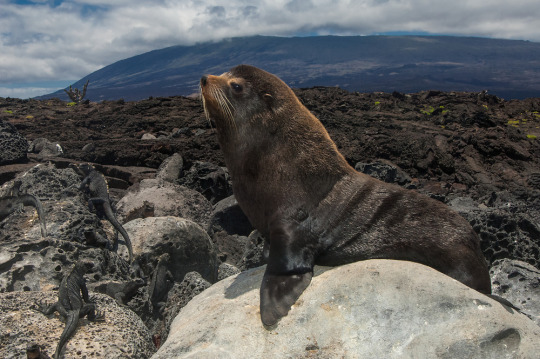
Brown fur seal (L) – also called the Cape fur seal, South African fur seal, or Australian fur seal this otariid lives on the southern coast of Australia and on the southern and southwestern coast of Africa. Described as "the largest and most robust" fur seal, these big bois (and girls) have been observed attacking and killing sharks. They prefer to live on rocky beaches, and like many pinnipeds the pups have a unique cry that lets their mothers find them even on a crowded breeding site.
Galapagos fur seal (R) – native to the Galapagos Islands (need I say?), the Galapagos fur seal is the smallest otariid and has the least sexual dimorphism of all the fur seals. They also have the lowest reproductive rate, nursing their pups for up to three years. Some Galapagos fur seal mothers even nurse two pups at a time! Despite having been legally protected in Ecuador since 1934, they are listed as an endangered species on the IUCN Red List.
#brown fur seal#galapagos fur seal#fur seal#pinnipeds#pinniped#otariidae#marine mamals#tumblr pinniped contest#round 1
15 notes
·
View notes
Text
#1902 - Phocarctos hookeri - New Zealand Sealion

Spotted on the beach at Sandfly Bay on the South Island. @purrdence didn’t want to get any closer because she didn’t want to disturb the animal, and sealions are entirely capable of biting your face off if they feel threatened. They are one of the largest remaining native animals in New Zealand, with males up to 350 centimetres long and weighing up to 450 kilograms.
The Māori call them pakake, whakahao (male) and kake (female), and they’re endemic to New Zealand and its subantarctic islands. They’re the rarest sealion species with only 12,000 or so in the world - 99% of the global population breed on the Auckland and Campbell Islands, and they only started pupping again on the mainland in 1995. The entire mainland population was wiped out by hunters in the mid-19th century, but not for the first time. A previous genetically distinct population had been wiped out by the Maori between 1300 and 1500 CE, until they were replaced by ones from the Subantarctic, and a third population in the Chatham Islands wiped out by the Moriori around 1500 CE.
Pakake are unique among pinnipeds in that they prefer to have their pups up to 2km inland, in forests. This allows them to avoid aggressive males, severe weather, and parasitic infection, and is probably only possible because New Zealand had no large predators apart from the enormous Haast’s Eagle, right up until humans arrived. The eagles probably enjoyed the change in diet when they did.
The sealion’s diet includes various fish, crustaceans, cephalopods, seabirds, and other mammals including the New Zealand Fur Seal, but over a quarter of adult seals show scarring from close encounters with Great White Sharks. Populations are also threatened by starvation, introduced disease, car collisions when moving inland to pup, and attacks by people and dogs.
17 notes
·
View notes
Note
“seal” is actually the common name for pinnipeds. pinnipeds are composed of theee major families: odobenidae (only living species is walruses), otariidae (fur seals and sea lions, the eared seals), and phocidae (the “true” seals, or earless seals). otariids and odobenids share a common ancestor with bears, but pinnipeds’ closest relatives are musteloids like raccoons, skunks, weasels, and red pandas. their whiskers help them sense vibrations underwater. otariids and odobenids can actually turn their hind flippers forward and under the body, which lets them almost walk on land. they are better at moving around on land than phocids, which move by lunging and wiggling a lot. all species of pinnipeds have fur covering their entire bodies, except for walruses. when diving underwater, pinnipeds usually exhale half of the air in their lungs, and then close their nostrils and throat cartilage in order to protect their trachea, which is flexible enough to collapse under pressure. they have very unique lung structure. their airways are reinforced with smooth muscle and cartilage rings, and their alveoli can complete deflate when they are diving deep. pinnipeds can reinflate their lungs, even after complete respiratory collapse. species of pinnipeds that specialize in deep dives, such as elephant seals, have very high blood volumes. their blood volumes can make up to 20% of their total body weight. to keep their blood pressure stable and reduce heart rate when diving, they have an elastic aorta to dissipate some energy of each heartbeat. pinnipeds, like many marine mammals, sleep with half their brain in the water. unlike many other marine mammals, they sleep with both halves of their brain when on land.
Ok so what im getting is:
walruses are the naked mole rats of pinnipeds
vampires would have a field day with the amount of blood volume these guys have
good sleep time
17 notes
·
View notes
Text

I posted 445 times in 2022
That's 41 more posts than 2021!
119 posts created (27%)
326 posts reblogged (73%)
Blogs I reblogged the most:
@geckosquid
@lostlegendaerie
@niallblogs
@pandoramusicbox09
@birbmania
I tagged 390 of my posts in 2022
Only 12% of my posts had no tags
#animal crossing - 96 posts
#animal crossing fish explained - 88 posts
#fish - 84 posts
#science in video games - 80 posts
#marine biology - 78 posts
#animals - 71 posts
#animal crossing pocket camp - 68 posts
#pokemon - 43 posts
#acpc - 41 posts
#art - 32 posts
Longest Tag: 135 characters
#what they should do is remake ingo's model so that he's still wearing his pearl clan stuff under either a new coat or his ripped up one
My Top Posts in 2022:
#5
Animal Crossing Fish - Explained #164
Brought to you by a marine biologist who is very tired...
CLICK HERE FOR THE AC FISH EXPLAINED MASTERPOST!
Work has just been kicking my ass. I could definitely do like a seal and just lay around until I’m hungry. Unfortunately for seals, they have to get into the ocean to find their food (I just have to walk to the fridge). Despite their large size and agility underwater, seals have to contend with the fact that they aren’t at the top of the food chain and need to be wary of bigger, scarier things (like killer whales and sharks). Now, you might be surprised to find out that not all seals are built the same way. Today I’m going to use Phineas as a great starting point to talk about pinnipeds - the seals, sea lions, and walrus.
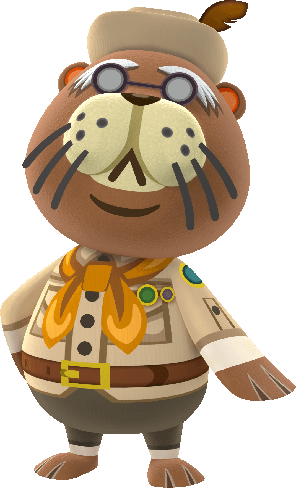
Phineas was an NPC in AC City Folk and New Leaf that gave the player things - either balloons or other cute toys or, in New Leaf, badges for completing some milestone. Unfortunately he doesn’t show up in ACNH, which is a shame, but understandable - Tom Nook now gives you all of your achievements and those toys are given out by Isabelle or some other seasonal NPC.
Anyway, Phineas is definitely a sea lion, *not* a true seal, and I will explain. So, all of these sea-puppy animals are in the clade Pinnipedia, which means “fin foot”. Pinnipeds are closely related to mustelids - like the sea otter and river otters we have covered - and the two are closely related to bears. So, if you think seals are cute and cuddly, they are the first thing, but maybe not the second thing. They can be aggressive, large, and fast, despite how awkward they are on land, and they have very sharp teeth and claws on their flippers. Give them a wide berth if you see them at the beach. Pinnipeds can be split into two neat groups - eared seals and true seals (the walrus falls under the first category, but we will talk about them when we cover Wendell). As the names suggest, eared seals (family Otariidae, sea lions and fur seals) have ear flaps and true seals (family Phocidae) do not.
There are also a great many differences between the groups, such as the way they swim and walk. True seals are much more adapted to the aquatic lifestyle than eared seals - their hind legs are held backwards and they cannot bring them under themselves to walk like other Carnivorans (the Order that includes lions, tigers, and bears, oh my!). So, to get around on land, they scooch about on their bellies. They are really great swimmers though and they collectively dive deeper than eared seals.
See the full post
37 notes - Posted February 12, 2022
#4
Animal Crossing Fish - Explained #156
Brought to you by a marine biologist with a not-jellyfish...
CLICK HERE FOR THE AC FISH EXPLAINED MASTERPOST!
I think this is finally where I’m going to throw up my hands and say right at the beginning that I don’t know what species these are. I would need a lot more information on these comb jellies than what the sprites give me, so we’ll have to make due with going through this group, as fascinating as it is, and learn what features they might have.

See the full post
38 notes - Posted January 6, 2022
#3
Animal Crossing Fish - Explained #170
Brought to you by a marine biologist and another we’ve done already...
CLICK HERE FOR THE AC FISH EXPLAINED MASTERPOST!
I’m totally fine doing fish we have kind of done already. I just hope none of ya are bored. Writing one of these only scratches the surface of information about that animal, and I try to pick a trait or behavior that I can expand on in general. Believe it or not, it’s only gotten *slightly* more difficult to find something to talk about in general...or maybe I just find every fish wonderful. Who knows...
Anyway, today I will cover two fish at a time because they are the same fish - the Red and the Black Wakin Goldfish!

See the full post
57 notes - Posted February 21, 2022
#2
Animal Crossing Fish - Explained #209
Brought to you by a marine biologist with different fish, same name...
CLICK HERE FOR THE AC FISH EXPLAINED MASTERPOST!
So, today we will cover the Silver Arowana, and I know what you’re thinking - gee, that sounds familiar. Didn’t we already cover the Arowana way back in like 2020 or whatever? And, yes, we did, but it was a different species, and I’m here to be wildly accurate and complete in my coverage of all the fish and aquatic friends in this franchise, so here we go!

The Silver Arowana first appeared in AC Pocket Camp in June 2021 for Fishing Tourney 39 that featured fish named after precious stones or metals - so that tourney also included the Black Ruby Barb we covered just a few entries ago. The Silver Arowana is a mostly tropical species, native to South American rivers. So, it’s pretty cool ACPC released it in the summer. Makes sense.
Anyway, so we all know that there is a species of Arowana in AC New Horizons - I covered it already and found that one was the Super Red color morph of the Asian Arowana. Both the Asian and Silver Arowanas belong to the same Family of fish - the Osteoglossidae, or the bony tongues. The name is derived from a sharp, toothed bone at the bottom of the mouth that can grind against teeth at the roof of the mouth. The family is tiny, comprised of just the arowanas and arapaimas, for which there are only about 14 species. The arowanas are divided into two Genus - the Scleropages, which is where the Asian Arowana comes from, and Osteoglossum, which today’s Silver Arowana (Osteoglossum bicirrhosum) resides.
See the full post
69 notes - Posted July 3, 2022
My #1 post of 2022
Animal Crossing Fish - Explained #155
Brought to you by a marine biologist and another fish tied to a legend...
CLICK HERE FOR THE AC FISH EXPLAINED MASTERPOST!
Figured I’d go with this “mythos” theme until I can’t anymore or I get bored. Whichever comes first, really. So, today I bring another Pocket Camp friend who’s gorgeous pattern may just be its undoing - the Achilles Surgeonfish.
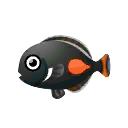
This is a summer time fish in Pocket Camp’s Saltwater Shores. It first appeared in July of 2018 and returned for the late summer to fall of 2019. Which makes sense. In real life, the Achilles Surgeonfish, or Achilles Tang (Acanthurus achilles) is a tropical reef fish, common around reefs throughout Oceania and across the Pacific Ocean to Hawaii. They are chiefly algae-eaters, grazing algae off of the coral reef, which benefits the corals immensely by preventing algae from smothering them. Just like it’s cousin the Regal Blue Tang we covered a long long time ago, the Achilles also has a sharp, scalpel-sharp spine by the base of its tail, helping to form the corner of the striking orange, tear-drop pattern.
See the full post
100 notes - Posted January 4, 2022
Get your Tumblr 2022 Year in Review →
3 notes
·
View notes